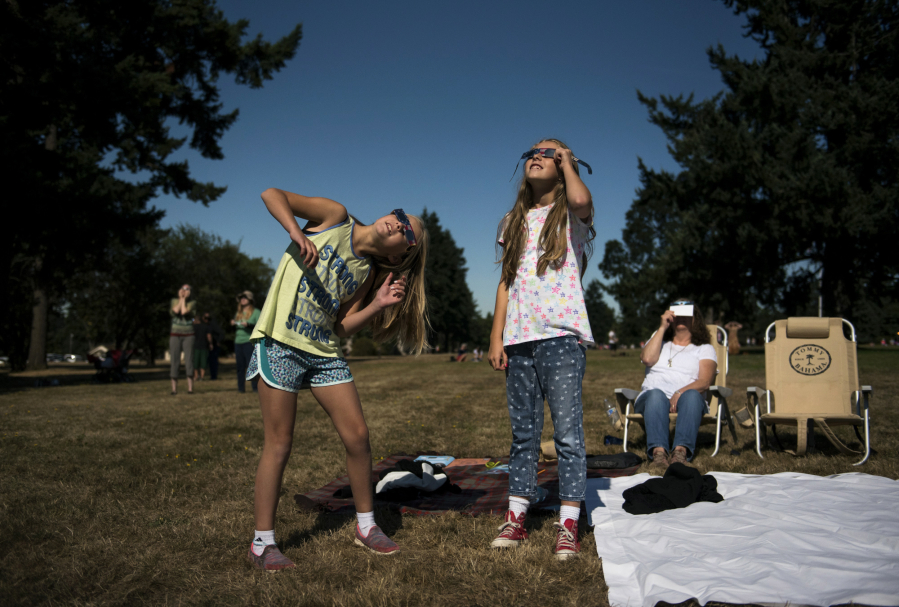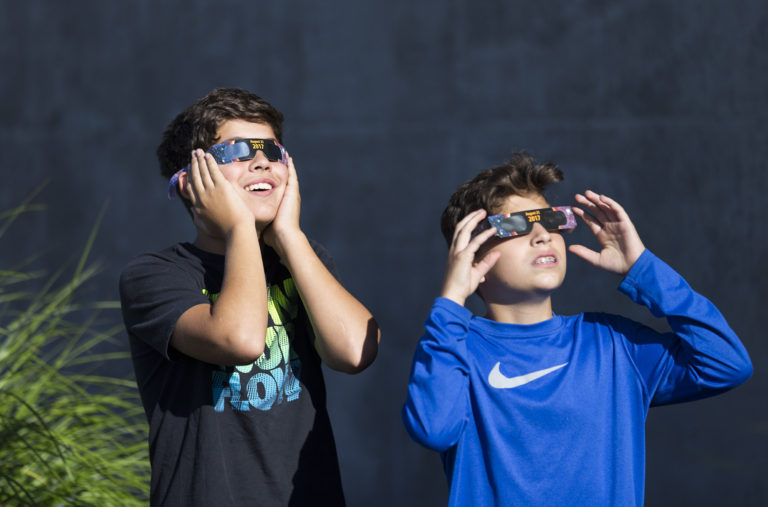The sun and moon lined up with Katie, Aiden, Lillie, Kendall, Kayden, Raphael, Michael and Michelle and … well, with everybody from coast to coast, actually.
Hundreds gathered Monday in several spots in downtown Vancouver to witness the first total solar eclipse visible from the continental United States since 1979.
It was called the All-American Eclipse because it was visible to people in all lower 48 states. But one host offered a much more personal perspective on Monday’s eclipse: It was a chance to “see sun and moon align with you.”
That was the message on a National Park Service card distributed Monday morning at Fort Vancouver. The national historic site hosted one of downtown Vancouver’s eclipse gatherings, as did the Vancouver Community Library and the Fort Vancouver National Trust.
Other groups gathered outside their workplaces and at public venues such as Esther Short Park as they waited for Clark County to reach our 99 percent totality at 10:18 a.m.
Many people turned the eclipse watch into a family event, building new memories while sharing old ones.
Orchards resident Maria Gomulkiewicz brought her children Katie, 8, and Aiden, 4, and their cousin Lillie, 9, of Yacolt.
“I just want them to witness what’s possibly a once-in-a-lifetime experience,” Gomulkiewicz said.
Katie was working on a Junior Ranger eclipse project while waiting for things to darken.
“The moon is going to cover the sun, and they’re all in a line like this,” the 8-year-old girl said as she pointed to an illustration.
Aiden offered some play-by-play as he put on his eclipses glasses to view the moon’s progress across the sun: “It’s biting and biting.”
Battle Ground sisters Jackie Schroeder and Susan Caulk were remembering an eclipse from their childhood with Susan’s daughter, Laura Kramer.
“Our father was a physicist,” Caulk said. “He used a candle to make smoked glass so we could watch the eclipse.”
She doesn’t remember much about the 1950s eclipse in Maryland, but “I remember him making the smoked glass,” Caulk said.
David and Debbie Lund of Camas brought their grandchildren, 11-year-old Kendall Williams and Kayden Williams, 9. And their memories will be more tangible than a selfie.
David Lund displayed one of the painted rocks they made commemorating the 2017 eclipse.
“We wanted to make it memorable,” Lund said.
Vianney Uwizeye of Vancouver brought his three children to Fort Vancouver for the eclipse.
“I wanted them to watch it,” Uwizeye said. There were eclipse viewing glasses for 11-year-old Michelle, 9-year-old Michael and Raphael, 6. The glasses provided a more direct view than he had while watching a 1979 eclipse in Rwanda. Then, they filled a basin with water and watched the eclipse reflected in the surface of the water, Uwizeye said.
At 10 a.m. or so, the solar disc was almost shuttered. A few people pulled on hoodies and sweaters as the temperature dipped.
The faces looking up at the eclipse were washed with an odd illumination, something like twilight but without the lengthening shadows that accompany the setting sun. Street lights clicked on along Evergreen Boulevard at 10:15 a.m.
Within a couple of minutes, the solar disc was reduced to a thin crescent and the moon slowly began to disengage. By 10:30, people were folding up their chairs and heading for home.





